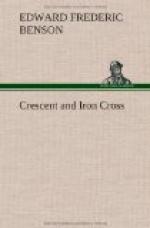All this reorganisation of the Turkish army was of course a very expensive affair, and required skilful financing, and it was necessary to get the whole of Turkey’s exchequer arrangements into German hands. A series of financial regulations was promulgated. The Finance Minister, during 1916, was still Turkish, but the official immediately under him was a German. He was authorised to deposit with the Controllers of the Ottoman National Debt German Imperial Bills of LT30,000,000, and to issue German paper money to the like amount. This arrangement insures the circulation of the German notes, which are redeemable by Turkey in gold two years after the declaration of peace. Gold is declared to be the standard currency, and no creditor is obliged to accept in payment of a debt more than 300 piastres in silver or fifty in nickel. And since there is no gold in currency (for it has been all called in, and penalties of death have been authorised for hoarders) it follows that this and other issues of German paper will filter right through the Empire. At the same time a German expert, Dr. Kautz, was appointed to start banks throughout Turkey in order to free the peasants from the Turkish village usurer, and in consequence enslave them to the German banks. Similarly a German was put at the head of the Ottoman Agricultural Bank. These new branches worked very well, but it is pleasant to think that one such was started by the Deutsche Bank at Bagdad in October 1916, which now has its shutters up. Before this, as we learn from the Oesterreichischer Volkswirt (June 1916), Germany had issued other gold notes, in payment for gold from Turkey, which is retainable in Berlin till six months after the end of the war. (It is reasonable to wonder whether it will not be retained rather longer than that.) These gold notes were accepted willingly at first by the public, but the increase in their number (by the second issue) has caused them to be viewed with justifiable suspicion, and the depreciation in them continues. But the Turkish public has no redress except by hoarding gold, which is a penal offence. That these arrangements have not particularly helped Turkish credit may be gathered from the fact that the Turkish gold L1, nominally 100 piastres, was very soon worth 280 piastres in the German paper standard, and it now fetches a great deal more.




